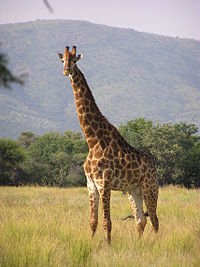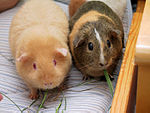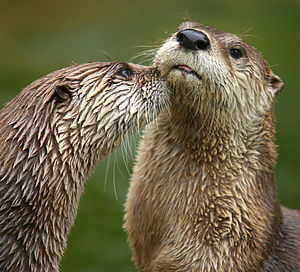
Portal:Mammals
|
edit
MammalsMammals ( class Mammalia) are vertebrate animals characterized by the presence of sweat glands, including milk producing sweat glands, and by the presence of: hair, three middle ear bones used in hearing, and a neocortex region in the brain. Mammals, other than the monotremes, give birth to live young instead of laying eggs. They also possess specialized teeth and use a placenta in the ontogeny. The mammalian brain regulates endothermic and circulatory systems, including a four-chambered heart. Mammals encompass approximately 5,400 species, ranging in size from the Bumblebee Bat, (30-40mm), to the Blue Whale, (33,000mm), distributed in about 1,200 genera, 153 families, and 29 orders, though this varies by classification scheme. Most mammals belong to the placental group. The four largest orders within the placental mammals are Rodentia (mice, rats, and other small, gnawing mammals), Chiroptera (bats), Carnivora (dogs, cats, bears, and other mammals that primarily eat meat), and Cetartiodactyla (including numerous herbivore species, such as deer, sheep, goats, and buffalos, plus whales). Phylogenetically, Mammalia is defined as all descendants of the most recent common ancestor of monotremes (e.g., echidnas and platypuses) and therian mammals ( marsupials and placentals). This means that some extinct groups of "mammals" are not members of the crown group Mammalia, even though most of them have all the characteristics that traditionally would have classified them as mammals. These "mammals" are now usually placed in the unranked clade Mammaliaformes. The mammalian line of descent diverged from the sauropsid line at the end of the Carboniferous period. The sauropsids would evolve into modern-day reptiles and birds, while the synapsid branch led to mammals. The first true mammals appeared in the Jurassic period. Modern mammalian orders appeared in the Palaeocene and Eocene epochs of the Palaeogene period.
edit
Selected article
The Guinea pig (also commonly called the cavy after its scientific name) is a species of rodent belonging to the family Caviidae and the genus Cavia. Despite their common name, these animals are not pigs, nor do they come from Guinea. They are native to the Andes, and while no longer extant in the wild, they are closely related to several species that are commonly found in the grassy plains and plateaus of the region. The guinea pig plays an important role in the folk culture of many indigenous South American groups, especially as a food source, but also in folk medicine and in community religious ceremonies. Since the 1960s, efforts have been made to increase consumption of the animal outside South America. In Western societies, the guinea pig has enjoyed widespread popularity as a household pet since its introduction by European traders in the 16th century. Their docile nature, their responsiveness to handling and feeding, and the relative ease of caring for them, continue to make the guinea pig a popular pet. Organizations devoted to competitive breeding of guinea pigs have been formed worldwide, and many specialized breeds of guinea pig, with varying coat colors and compositions, are cultivated by breeders.
edit
Did you know?
edit
Selected pictureThe Otter (Lontra canadensis) is a North American member of the Mustelidae or weasel family. It is also known as the North American River Otter. It is a common animal in North American waterways. Its numbers have significantly dropped since Europeans came to colonize the Americas edit
Scientific classification
|




